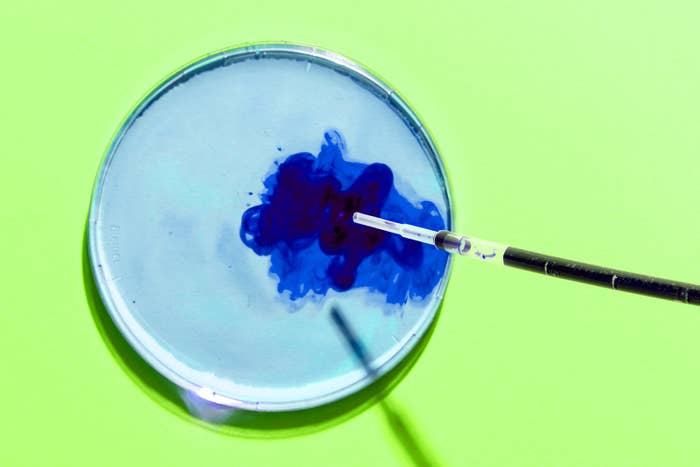
In an experimental treatment, a 7-year-old boy with a rare genetic skin disorder has had 80% of his skin replaced with grafts made from his own cells.
The 7-year-old was admitted to the burns unit of a children's hospital in Bochum, Germany, with blisters all over his body in June 2015. It wasn't long before he'd lost over half of the total surface area of the top layer of his skin.
The blisters were caused by a rare genetic skin disease called junctional epidermolysis bullosa, or JEB, that makes a person's skin fragile. For people with JEB, minor knocks and scrapes can cause skin to turn raw and blistered.
"After two months we were sure we could do absolutely nothing for this kid and that he would die," Tobias Rothoeft, a doctor at Ruhr University Bochum in Germany, told a press briefing. "His parents asked us to try anything we could."
So they looked again at the scientific literature on this condition, and got in touch with Michele De Luca, director of the centre for regenerative medicine at the University of Modena and Reggio Emilia, Italy.
By taking skin cells from a small area of the 7-year-old's skin that was healthy, and genetically correcting those cells, De Luca's team created new, healthy skin grafts. In three separate operations, the first of which took place in October 2015, the patient's doctors successfully replaced 80% of his skin with the new grafts.
Cédric Blanpain, professor of stem cell and developmental biology at the Université Libre de Bruxelles in Belgium, told BuzzFeed News that this study contains "many firsts".
"This is one of the first studies that clearly shows the enormous potential of stem cell therapy," he says. "And also it's one of the first studies, and in the skin it is the first, that shows you can correct genetically deficient stem cells."
Almost two years after his operations, the patient's skin is holding up well, says De Luca, author of a paper detailing the case published in the journal Nature today.
"He went back to a normal life, including school and sports games," De Luca said at a press briefing. "His epidermis [the top layer of his skin] is stable and robust."
The skin grafts were grown in Italy, where De Luca works, and transported to Germany for the operations. The new skin – with a total area of 0.85m² – was grown in a similar way to the method used for burns patients, starting with taking a small biopsy from an unaffected part of the patient's skin. But before the skin was grown, De Luca and his colleagues inserted a healthy version of the gene responsible for causing the skin disorder. This whole method has been done before, but never on such a large scale.
Unlike in a typical burns patient, the patient's new skin has been able to grow hairs and sweat glands. "He’s still got some blisters in the non-transplanted areas, covering about 2-3% of his body area now," says De Luca. "But he never got blisters where we transplanted him."
Epidermolysis bullosa (EB) is a group of genetic skin conditions that affects an estimated 5000 people in the UK. JEB is a rare subtype that affects roughly 10% of those people, and can be severe.
The disease is caused by a fault in the proteins that hold the two outer layers of skin together. When these "anchoring" proteins don't work as they should, the top layer of skin – the epidermis – can separate from the the layer below – the dermis – in minor scrapes, causing blistering and ulcers, and leading to painful wounds that don't heal. At the moment there is no cure for the condition.
"Great strides in our understanding of the molecular and genetic bases of EB have been made in the past 20 years," Emma Wedgeworth of the British Association of Dermatologists, told BuzzFeed News. "Hopefully now, we are starting to see this translate into more effective treatments."
She says stem cells therapy holds promise for the treatment of the skin disorder, but results from trials so far – many of which use stem cells not from the patient themselves – have been "variable".
"This patient has had a very good result from taking their own skin stem cells, correcting the genetic mutation causing EB, growing the skin cells and then grafting on the new, unaffected skin cells," she says. "It's really great to see that this approach has worked and it offers real hope to sufferers of EB."
The procedure is not close to becoming a mainstream treatment yet, however. Whether or not there'll be any long term health effects from the procedure also remains to be seen.
"It is worth noting that this is just one patient, more research will have to be done before we see this being used as a mainstream treatment for EB," says Wedgeworth. "Also as this treatment involved grafts to 80% of the patient’s body there are clearly logistical challenges.”
Not all forms of the disorder come from the same genetic mistake, either. "This one is probably one of the most easy forms to genetically correct," says Blanpain. "There's other forms of the disease which is going to be a little bit more difficult to fix the gene, and for which we're going to need probably new strategy."
Still, in an accompanying article in Nature, Blanpain and a colleague write that the work "marks a major step forward in the quest to use stem-cell therapies to treat disease."
"There's a great hope that these cells can one day be used for clinical therapy," he told BuzzFeed News. "But actually [so far] there have been very few studies that demonstrate stem cells can be used for clinical therapy, to benefit patients with severe disease."
